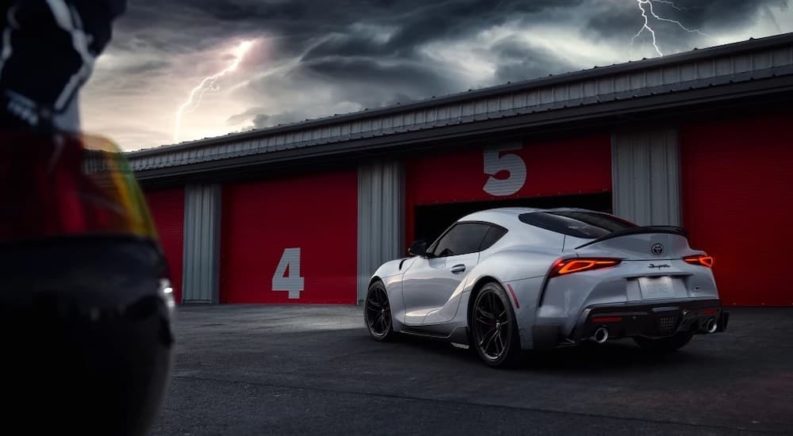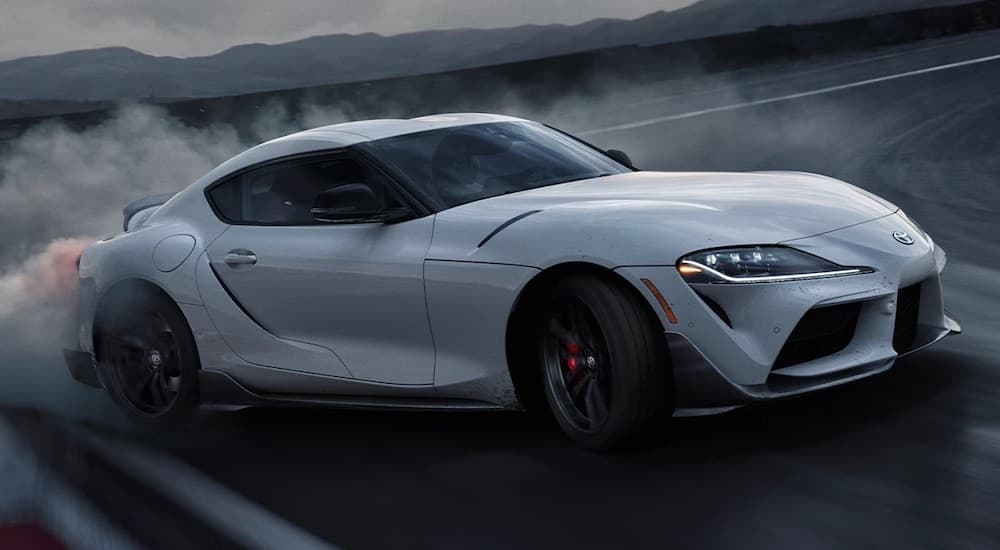The Supra has long been Toyota’s halo car, that is, a place for the automaker to showcase the latest innovations in technology, styling, and performance. Sure, the sports car has never been one of the brand’s bestsellers, with average annual sales of around six thousand cars since its rerelease for 2020. Still, among those in the know, the Supra has gained cult-like status thanks to its reputation for high-octane performance.
First introduced in 1979, Toyota has continued to refine the Supra over the years, perfecting the powertrain and folding in a number of new features that have gone a long way in keeping the model fresh. The Supra was discontinued in 2002 but burst back onto the scene in 2019. And while the current 2022 Toyota GR Supra is a great example of everything there is to love about Toyota’s souped-up sports car, it’s the upcoming 2023 model that marks one of the most significant additions in recent history.
For 2023, Toyota has announced that the Supra will be available with an optional six-speed manual transmission for the 3.0-liter inline-six engine. It’s a long-overdue feature–and one that we were starting to think might never happen––but it’s more than worth the wait with the 2023 Toyota GR Supra finally getting a sporty transmission to match its sporty, well, everything else.
But what’s the big deal? Today’s automatic transmissions have come a long way and are much easier to use. Yet, the announcement of the Supra’s long-awaited manual option is still making waves in the gearhead community. We’ll dive into the Supra’s history and explore some of the advantages of a manual transmission over the automatic layout, especially when it comes to a high-performance sports car like the GR Supra.
Excelling Out Of The Gate
The Supra didn’t start out as its own model but rather as a variant of Toyota’s popular Celica in 1979. The brand was seeking a high-performance sports car that could compete with the Z-car from fellow Japanese automaker Nissan and settled on the Celica as the ideal platform to realize its automotive dreams. The original Celica Supra was both longer and wider than its namesake and, most importantly, featured an inline-six engine rather than the Celica’s four-cylinder setup.
The resulting mash-up was an instant success, with the Supra’s refined styling and high-end performance garnering praise from critics and drivers alike. The Celica Supra became Toyota’s halo car, showcasing the automaker’s prowess in high-performance engineering and subtle and luxurious styling. Sales of the second generation were so robust––around 115,000 units according to some estimates––that Toyota decided to spin off the Supra as its own model starting in mid-1986.
The sports cars dropped the Celica name and quickly consolidated its position on the upper end of the market, retaining its rear-wheel drive configuration and getting a new double-wishbone suspension and larger 3.0-liter inline-six that produced an impressive 200 hp. The Celica went in the opposite direction, adopting a new front-wheel drive layout and retaining the old four-cylinder engine. This change made the Supra Toyota’s new top-tier sports car, and the brand would go a long way to ensure its dominance in the coming years. For example, 1987 saw the instruction of a new turbo option, with the turbocharger boosting the sports car’s output up to 230 hp while cutting the Supra’s zero-to-60 time to just six seconds.
The Fourth-Generation Supra
The iconic fourth-generation Supra hit the market in 1993, introducing a host of optional upgrades that allowed the Supra to compete with some of the most hallowed names in sports car culture. This was made possible in part thanks to the legendary 2JZ engine, which, due to its twin turbocharger, could squeeze 330 hp out of the Supra’s 3.0-liter inline-six engine. This version of the Supra had incredible performance, but some of the luster must have worn off after its initial debut because outside of the Japanese market, sales started to falter. The fourth-generation Supra was pulled from the American market in 1998, and global production finally came to a close in 2002.
While it didn’t have the sales numbers it once had, the fourth-generation Supra remained popular among a loyal fan base that had grown to appreciate the Supra’s high-performance credentials. Toyota doubled down on what it does best, focusing on the Supra’s performance and producing a vehicle that would go on to have an unprecedented impact on both the automotive world and pop culture as a whole. The car gave Toyota the chance to show off its engineering chops with a 320 hp engine, 315 lb-ft of torque, and a zero to 60 time of just 4.9 seconds. This was made possible in part thanks to the 2JZ’s twin turbochargers, which, since they operated sequentially rather than in parallel, provided quicker low RPM response and increased boost at higher RPMs.
Toyota also addressed the Supra’s weight as a means of improving performance. Past models had come in a little heavier than average, hurting the sports car’s power-to-weight ratio and making it difficult to compete with some higher-end models on the market. For the fourth generation, Toyota cut the pounds wherever it could find them, introducing a new aluminum hood, front cross member, forged upper suspension arms, and oil and transmission pans. A magnesium-alloy steering wheel, plastic gas tank, and gas-injected rear spoiler rounded out the Supra’s weight-saving changes, allowing the new model to tip the scales at 200 lbs lighter than previous versions.
This generation of the Supra become legendary among those in the know, with a 1994 model earning its 15 minutes of fame as the “hero car” of the 2001 smash hit The Fast and The Furious. Even models that didn’t start in Hollywood blockbusters continue to garner interest from collectors, with a 1997 model selling for $176,000 at auction in 2019.
The Supra Strikes Back
The 2020 model year marked the return of the Supra after a 12-year hiatus from the American market. Sticking with the high-performance approach taken during the sports car’s fourth generation, the new Supra was part of Toyota’s Gazoo Racing (GR) family of performance vehicles. This designation comes with a higher price tag but allows Toyota to fold in all the high-end bells and whistles that make the Supra so fun to drive. Designed in partnership with BMW and using many parts from the BMW Z4, the GR Supra brought the car back with a bang. The new Supra is rear-wheel drive, filled with performance features, and is offered with four-cylinder and six-cylinder turbocharged engines. The 3.0-liter inline-six B58 engine can produce as much as 383 hp for a zero to 60 time of just 4.4 seconds.
Each year since the fifth generation was launched, the Supra has seen major changes, and 2023 will bring another––the return of a manual transmission. While the manual layout had been offered with select engines during previous generations, the 2023 GR Supra will be the first fifth-generation model to include the option. The six-speed manual transmission is available when opting for the 3.0-liter inline-six engine, giving drivers unparalleled control behind the wheel. Toyota redesigned the clutch, housing, and driveshaft to accommodate the six-speed manual layout. This includes adding stronger springs in the clutch, which allow the Supra to harness the engine’s considerable 368 lb-ft of torque without issue.
While manual transmissions have largely gone the way of the dinosaur, it’s encouraging to see Toyota embrace the old-fashioned setup in all of the brand’s latest sports cars. It’s a surprisingly rare option in today’s market, and even the GR Supra’s factory-mate, the BMW Z4, can’t compete. But what’s all the fuss about? Taking a technological step backward is rarely considered a good thing, but manual transmissions buck the trend, offering some significant advantages over their automatic counterparts, especially when you’re talking about a high-performance vehicle like the Supra GR.
The Benefits of a 6-Speed
First and foremost, the manual transmission experience comes down to control. With an automatic transmission, a vehicle shifts gears when it reaches a certain RPM range, taking the choice of exactly when to shift away from the driver. While the 8-speed currently in the 2022 Supra includes a manual mode and steering-wheel-mounted paddle shifters, it still can’t provide the same control and response as a true three-pedal manual transmission. With a manual, every decision is left to the driver’s discretion, giving them greater control and allowing them to plan how to attack certain stretches of road without any backseat driving from an automatic transmission.
A manual transmission simply offers better control, creating a more direct connection between the driver and engine without the delays one would experience in an automatic. When you step on the gas, there’s no automatic transmission to butt in and give its two cents, just a clean connection that runs from your shifter into the manual gearbox and then directly to the tires. This can make all the difference in racing scenarios where missing the timing on a particular gear change can mean the difference between walking away with the checkered flag and getting blown by.
Manual transmissions are also less prone to power loss than their automatic cousins. Known as “parasitic loss” in automotive jargon, this refers to the fact that certain car components, by their very nature, tend to sap energy from your powertrain. The oil pumps found in automatic transmissions are one prime culprit, robbing power from the engine in an effort to keep themselves pumping. There’s also the matter of the power lost to slippage, with torque converters wasting energy due to their inherently inefficient design. A manual transmission avoids these pitfalls by routing energy directly where it needs to go, making slippage and parasitic loss a thing of the past.
For drivers who are into modifying their rides, manual transmissions offer a number of advantages. Automatics, along with all the peripheral components that make them work, tend to make any engine modifications a much more difficult task. Furthermore, some mods can lead to calibration issues with an automatic transmission’s electronically controlled shift points, which can actually decrease a vehicle’s potential power––not exactly why people usually get into modding. A manual transmission is also a little less finicky than an automatic, especially when it comes to maintenance. There’s a lot of friction and heat at play when you’re talking about an automatic transmission, which means regular fluid and filter changes as the torque converter starts to heat up and the automatic transmission fluid starts to break down. More parts, more problems, but the relatively pared-down manual transmission avoids these issues thanks to its simple design.
Lastly, and perhaps, most importantly, it’s exclusive. We don’t mean this in a snobby sense but rather in a practical one. If you roll up to a summer barbecue behind the wheel of something like a GR Supra, be prepared to fend off a horde of friends who want to get behind the wheel and “just take it around the block a couple times.” In this day and age, the manual transmission should nip any of these would-be Andrettis in the bud, giving you a perfect chance to keep your insurance rates low and hit them with a withering “do you even know how to drive a stick?”
Can the Supra Get Even Better?
The 2023 Toyota GR Supra is a return to form for the storied sports car. That’s not to say that other iterations released as part of the Supra’s fifth-generation are anything to sneeze at, but the addition of a manual transmission just adds that element of excitement that should be the cornerstone of any performance driving experience. The Supra has long lived up to its reputation as Toyota’s halo car, introducing drivers to a slate of intriguing new technology, design, and engineering features, and the 2023 version is no different.
The Supra has come a long way since its debut as a trim of the Celica, building on what it does best to become one of the world’s––or at least Hollywood’s––most famous sports cars. Whether you’re a collector looking for an instant classic, an aspiring racer looking to test their mettle at the track, or just a Toyota die-hard eager to see what the brand has cooked up for the new year, the 2023 Toyota GR Supra is worth a closer look.






